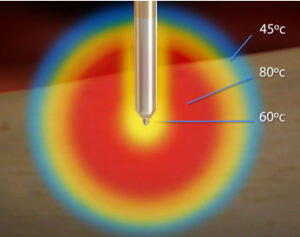Chronic hip joint pain is a prevalent condition for adults, occurring in seven percent of men and 10% of women.1,2 Osteoarthritis (OA) and avascular necrosis (AVN) are two primary causes of hip pain. Hip OA is the gradual degradation of hip cartilage, which can lead to painful bone-on-bone rubbing.3 It is observed in 9.2% of adults over 45.1 AVN occurs when the blood supply to the head of the femur is disrupted, which can cause painful rubbing between the hip and leg.4 Up to 20,000 new cases of AVN are diagnosed in the US annually; and this condition is the primary cause for 10% of hip replacements.4,5
Limitations of Conventional Management Options1
- Physical therapy, weight loss and a variety of pharmacologic agents are unable to provide long-term benefit
- Intraarticular injections require multiple doses and can have limited effectiveness and clinical durability
- May not be suitable in some candidates due to age and other comorbidities
 Advantages of Using COOLIEF* Cooled Radiofrequency
Advantages of Using COOLIEF* Cooled Radiofrequency
COOLIEF* Cooled RF is an option for patients who are not candidates for surgery or for those looking for pain relief via a minimally invasive, non-opioid procedure for chronic hip joint pain.
Specifically designed to treat complex anatomy of variable nerve courses, COOLIEF* Cooled RF uses water-cooled technology that enables more RF energy to safely deactivate pain-transmitting sensory nerves. This creates a larger, spherical lesion that distally projects 45% or greater beyond the probe’s tip, allowing physicians to approach the target nerve from any angle.
- Demonstrates up to 24 months pain relief with improved physical function and a reduction in opioid medication
- Delivers up to 3.7x more energy than standard RF usage
- Distal lesion projection feature of Cooled RF probes is well suited for this hard-to-reach area and allows for a familiar perpendicular approach to the target nerves, potentially resulting in reductions to procedure time and fluoroscopic exposure.
Evaluating CRFA in Patients with Chronic Hip Pain
A 2021 retrospective case series published in Pain Medicine examined the effect of CRFA on pain levels for subjects with chronic hip pain, as well as the technical approach for denervation. A total of 178 CRFA procedures among 84 subjects were performed, with follow up data collected over the course of 12 months. Researchers analyzed the 96 initial CRFA procedures performed on the subject group, evaluating for pain and opioid usage at six and 12 months using the Visual Analogue Score (VAS).
6-Month Results: VAS Pain Scores at 1- and 6-Month Time Points

Pain
Subjects who received CRFA experienced an average decrease of 3.86 points from baseline.
69% of subjects who received CRFA reported ≥50% pain relief.
12-Month Results
Pain
Subjects who received CRFA showed an average decrease of 3.07 points from baseline.
52% of subjects who received CRFA reported ≥50% pain relief.
Subjects who received CRFA experienced ≥50% pain relief for a median of 12 months.
Repeated CRFA treatments demonstrated consistency in pain relief.
Key Takeaway: CRFA is a safe, effective and straightforward treatment for chronic hip pain in patients with advanced OA, AVN or who have already undergone THA.

Click here for Instructions for Use
References:
- Kapural L, Jolly S, Mantoan J, et al. Cooled radiofrequency neurotomy of the articular sensory branches of the obturator and femoral nerves – combined approach using fluoroscopy and us guidance: technical report, and observational study on safety and efficacy. Pain Physician. 2018;21(3):279–284.
- Birrell F. Association between pain in the hip region and radiographic changes of osteoarthritis: results from a population-based study. Rheumatology. 2005;44(3):337-341.
- Mont MA, Hungerford DS. Non-traumatic avascular necrosis of the femoral head. J Bone Joint Surg Am. 1995;77(3):459-477.
- Naber J, Lee N, Kapural L. Clinical efficacy assessment of cooled radiofrequency ablation of the hip in patients with avascular necrosis. Pain Manag. 2019;9(4):355–359.
- Hsu H, Nallamothu SV. Hip Osteonecrosis. In: StatPearls [Internet]. Treasure Island (FL): StatPearls Publishing; 2021.

 Advantages of Using COOLIEF* Cooled Radiofrequency
Advantages of Using COOLIEF* Cooled Radiofrequency